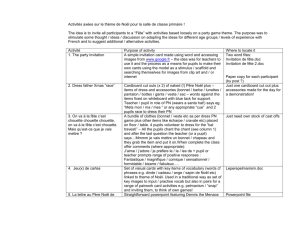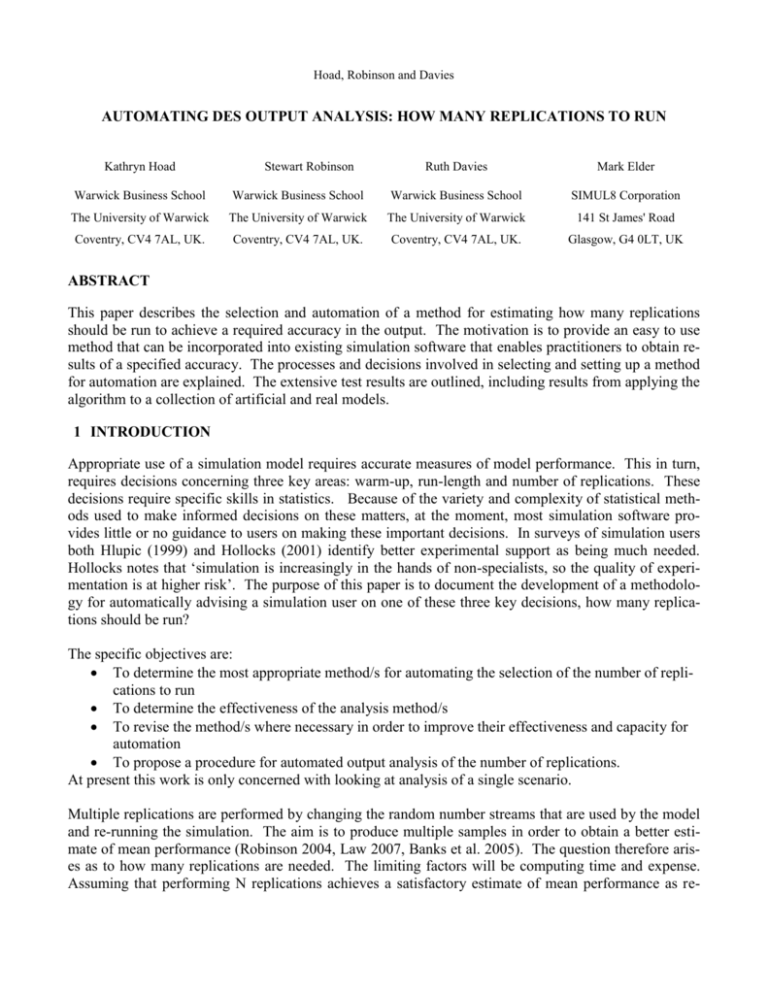
Hoad, Robinson and Davies
AUTOMATING DES OUTPUT ANALYSIS: HOW MANY REPLICATIONS TO RUN
Kathryn Hoad
Stewart Robinson
Ruth Davies
Mark Elder
Warwick Business School
Warwick Business School
Warwick Business School
SIMUL8 Corporation
The University of Warwick
The University of Warwick
The University of Warwick
141 St James' Road
Coventry, CV4 7AL, UK.
Coventry, CV4 7AL, UK.
Coventry, CV4 7AL, UK.
Glasgow, G4 0LT, UK
ABSTRACT
This paper describes the selection and automation of a method for estimating how many replications
should be run to achieve a required accuracy in the output. The motivation is to provide an easy to use
method that can be incorporated into existing simulation software that enables practitioners to obtain results of a specified accuracy. The processes and decisions involved in selecting and setting up a method
for automation are explained. The extensive test results are outlined, including results from applying the
algorithm to a collection of artificial and real models.
1 INTRODUCTION
Appropriate use of a simulation model requires accurate measures of model performance. This in turn,
requires decisions concerning three key areas: warm-up, run-length and number of replications. These
decisions require specific skills in statistics. Because of the variety and complexity of statistical methods used to make informed decisions on these matters, at the moment, most simulation software provides little or no guidance to users on making these important decisions. In surveys of simulation users
both Hlupic (1999) and Hollocks (2001) identify better experimental support as being much needed.
Hollocks notes that ‘simulation is increasingly in the hands of non-specialists, so the quality of experimentation is at higher risk’. The purpose of this paper is to document the development of a methodology for automatically advising a simulation user on one of these three key decisions, how many replications should be run?
The specific objectives are:
To determine the most appropriate method/s for automating the selection of the number of replications to run
To determine the effectiveness of the analysis method/s
To revise the method/s where necessary in order to improve their effectiveness and capacity for
automation
To propose a procedure for automated output analysis of the number of replications.
At present this work is only concerned with looking at analysis of a single scenario.
Multiple replications are performed by changing the random number streams that are used by the model
and re-running the simulation. The aim is to produce multiple samples in order to obtain a better estimate of mean performance (Robinson 2004, Law 2007, Banks et al. 2005). The question therefore arises as to how many replications are needed. The limiting factors will be computing time and expense.
Assuming that performing N replications achieves a satisfactory estimate of mean performance as re-
Hoad, Robinson and Davies
quired by the user, performing more than N replications may be an unnecessary use of computer time
and considerable expense. However, performing fewer than N replications could lead to inaccurate results and thus to incorrect decisions being made.
There are three main methods found in the literature for choosing N: Rule of Thumb (Law & McComas
1990), a simple Graphical Method (Robinson 2004) and the Confidence Interval (with Specified Precision) Method (Robinson 2004, Law 2007, Banks et al. 2005). Law and McComas (1990) recommend
running at least 3 to 5 replications. This rule of thumb is useful for telling users that relying upon the results of only one run is unwise. However, it makes no allowance for the characteristics of a model’s
output, so although running 3 to 5 replications may suffice for one model it may be woefully inadequate
for another.
In the simple graphical method a user carries out a series of replications and plots the cumulative mean
of a chosen output variable against n (the number of replications). The user can then visually select the
point on the graph where the cumulative mean line becomes “flat” and use this as the number of replications. This method has the advantage of being simple to understand and perform, as well as utilizing the
output of interest in the decision made. It is however subjective with no measured precision level. The
third main approach, Confidence Interval (with Specified Precision) Method, asks the user to make a
judgment as to how large an error they can tolerate in their model’s estimate of the true mean. Replications are then run, and Confidence Intervals constructed around the sequential cumulative means, until
this desired precision in the output is achieved. The advantage of this approach is that it relies upon statistical inference to determine the number of replications required. The disadvantage is that many simulation users do not have the skills to apply such an approach.
The Confidence Interval (with Specified Precision) Method was the one chosen to be adapted into an algorithm for automation and was then tested using artificial and real models. This method runs increasing numbers of replications until the confidence intervals constructed around the chosen output variable
(e.g. mean queue length) using the t-statistic, are within a (user) specified precision. This allows the user to tailor the accuracy of output results to their particular requirement or purpose for that model and result. This method assumes that the cumulative mean has a normal distribution, (which is true under the
Central Limit Theorem when the number of replications is large). We introduce and describe this simple
algorithm in the next section.
It has also been suggested that “stability” of the cumulative output variable should be considered as well
as precision in a stopping criteria (Robinson 2004). It has been proposed that it is not only important
that the confidence interval is sufficiently narrow but also that the cumulative mean line is reasonably
‘flat’. We therefore incorporated this extra stability criteria into our algorithm to produce an ‘extended
replication algorithm’. This extended algorithm is described in detail in Section 3.
Section 4 explains the methodology used to test both algorithms on a selection of artificial and real
models and Section 5 sets out the test results. A further addition to the simple algorithm is suggested
and described in Section 6. A discussion and final conclusions are found in Sections 7 and 8 respectively.
Hoad, Robinson and Davies
2 THE SIMPLE REPLICATION ALGORITHM
2.1
Overview and definitions of algorithm
This section sets out the algorithm, and describes and explains the definitions and mechanisms used.
Figure 1 shows how the replication algorithm interacts with the model in a sequential way in order to ascertain the number of replications required. Any and all input data and parameter values are fed into the
simulation model and the chosen output results produced. These model output results are input into the
replication algorithm which calculates whether the required precision criteria set by the user have been
met. If these have not, one more replication is made with the simulation model, and the new output value fed into the replication algorithm. This cycle continues until the algorithm’s precision criteria are
met.
We define the precision, dn, as the ½ width of the Confidence Interval expressed as a percentage of the
cumulative mean (Robinson 2004):
dn
100 t n 1,
sn
2
Xn
Where n is the current number of replications carried out,
n,
t n 1, is the student t value for n-1 degrees
2
of freedom and a significance of 1-α, X n is the cumulative mean and sn is the estimate of the standard
deviation, both calculated using results Xi (i = 1 to n) of the n current replications.
START:
Load
Input
Run one
more
replication
Run
Model
NO
Precision
criteria met?
Produce
Output
Results
Run
Replication
Algorithm
YES
Recommend
replication number
Figure 1: Flow diagram of the sequential procedure.
2.2
Stopping Criteria
The simplest method (Robinson 2004) is to stop as soon as dn is first found to be less than or equal to the
set desired precision, drequired (user defined), and to recommend that number of replications to the user
(Law 2007). But it is possible that the data series could prematurely converge to an incorrect estimate of
Hoad, Robinson and Davies
the mean with precision drequired by chance and then diverge again. In order to account for this possibility, when dn is first found to be less than or equal to the set desired precision, drequired, the algorithm is
designed to look ahead, performing a set number of extra replications, to check that the precision remains ≤ drequired. We call this ‘look ahead’ value kLimit. The actual number of replications checked
ahead is a function of this user defined value, f(kLimit):
kLimit ,
n 100
f (kLimit )
kLimit
n
, n 100
100
The function is constructed to allow the number of replications in the ‘look ahead’ to be in proportion
with the current number of replications, n. Hence, when n ≤ 100 the total number of replications
checked ahead is simply kLimit. But when n > 100, the number of replications is equal to the proportion
kLimit
n100
. This has the effect of relating how far the algorithm checks ahead with the current value of
n, while keeping the order of size consistent. See Figure 2 for a visual demonstration of the f(kLimit)
function.
The number of replications taken to reach the desired precision is referred to as Nsol in the algorithm.
140
kLimit=0
kLimit=10
120
kLimit=5
kLimit=25
f(kLimit)
100
80
60
40
20
0
470
433
396
359
322
285
248
211
174
137
100
3
replication number (n )
Figure 2: The f(kLimit) ‘look-ahead’ function for 4 different values of kLimit.
2.3
The Simple Replication Algorithm
The Simple Replication Algorithm is as follows:
Hoad, Robinson and Davies
Let n = 3
Set drequired
Set kLimit
Run n replications of model.
While Convergence Criteria not met Do
Calculate cumulative mean, ( X n ), confidence limits, and precision, ( dn ).
If dn ≤ drequired
Let Nsol be equal to n, the number of replications required to reach drequired.
If kLimit > 0
Calculate f(kLimit).
If the Convergence Criteria is met i.e. dn+1,…,dn+f(kLimit) ≤ drequired.
Then
Recommend Nsol replications to user
Else
Perform one more replication.
Loop
Figure 3 is a visual example of the Simple Replication Algorithm. In this example the kLimit ‘look
ahead’ value is set at 5 and the required precision is set at 5% (i.e. drequired = 5). The first time the precision dn is less than or equal to 5 occurs at n = 8 replications. Nsol is therefore set to 8 replications.
Then, as n < 100, the algorithm continues for 5 more replications, calculating dn at n = 9, 10, 11, 12 and
13 replications. If at any point dn becomes greater than 5%, the ‘look ahead’ procedure is stopped. Nsol
then becomes set to the next number of replications where dn ≤ 5 and the ‘look ahead’ procedure is repeated. In this visual example, the cumulative mean ( X n ) and Confidence Intervals are well behaved
and dn stays below 5% for the entire 5 ‘look ahead’ replications. The algorithm, in this case, stops running after 13 replications and advises the user that 8 replications is sufficient (with these particular random streams) to achieve the required precision of 5%.
3 THE EXTENDED REPLICATION ALGORITHM
This second replication algorithm extends the first simple algorithm by adding an extra stability criteria
procedure into the existing ‘look-ahead’ procedure. As explained in the introduction, it has been proposed that it is not only important that the confidence interval is sufficiently narrow but also that the
cumulative mean line is reasonably ‘flat’ (Robinson 2004). In order to check for ‘flatness’ of the cumulative mean line the extended algorithm ‘draws’ two parallel lines called Inner Precision Limits (IPLs)
around the cumulative mean line. These are defined as a percentage of the drequired value. If the cumulative mean crosses either IPL within the ‘look ahead’ period, then the stability criteria is violated. The
stability criteria is treated as being strictly inferior to the precision criteria procedure. This means that
the stability of the cumulative mean is not checked until dn stays ≤ drequired for the entire ‘look-ahead’ period.
Hoad, Robinson and Davies
37
Precision ≤ 5%
35
X
Upper 95%
Confidence Limit
33
X, Cumulative Mean
31
Lower 95%
Confidence Limit
29
27
f(kLimit)
25
Nsol
Nsol +
f(kLimit)
23
3
4
5
6
7
8
9 10 11 12 13 14 15 16 17 18 19 20
Replication number (n )
Figure 3: Graphical example of the simple replication algorithm with a kLimit ‘look ahead’ value of 5
replications.
3.1
Further Definitions
The extended algorithm uses the same definitions as described for the simple algorithm (Section 2.1)
with added definitions for the Inner Precision Limits (IPLs).
IPLrequired
IPLrequired
X
d
X
d
Nsol 100
Nsol 100
required
required
IPLupper X Nsol
, IPLlower X Nsol
100
100
where IPLrequired is described as a percentage of the set drequired value.
3.2
Extended Replication Algorithm
The extended algorithm is essentially the same as the Simple Algorithm but with the added stability criteria included into the pre-existing convergence criteria. The extended algorithm is as follows:
Hoad, Robinson and Davies
Let n = 3
Set drequired
Set kLimit
Set IPLrequired
Run n replications of model.
While Convergence Criteria not met Do
Calculate cumulative mean, ( X n ), confidence limits, and precision, ( dn ).
If dn ≤ drequired
Then
Let Nsol be equal to n, the number of replications required to reach drequired.
If kLimit > 0
Then
Calculate f(kLimit).
If dn+1,…,dn+f(kLimit) ≤ drequired.
Then
If Stability Criteria also met i.e. X n 1,..., X n f ( kLimit ) are within IPLs
Then
Convergence Criteria met: Recommend Nsol replications to user
Else
Convergence Criteria not met: Perform one more replication.
Else
Convergence Criteria not met: Perform one more replication.
Loop
Figure 4 is a visual example of this extended replication algorithm. It is a repeat of the visual example
for the simple algorithm shown in Figure 3, with the IPLs inserted. As before, the kLimit ‘look ahead’
period is set at 5 replications and the required precision is 5% (i.e drequired = 5). The Inner Precision
Limits are set at 50% of the drequired value. The first time the precision dn is less than or equal to 5 still
occurs at n = 8 replications. Nsol is therefore set at 8 replications. Then, as for the Simple Algorithm,
as n < 100, the algorithm continues for 5 more replications, calculating dn at 9, 10, 11, 12 and 13 replications. If at any point dn becomes greater than 5%, the ‘look ahead’ procedure is stopped. Nsol then becomes set to the next number of replications where dn ≤ 5 and the ‘look ahead’ procedure is repeated. In
this visual example, the cumulative mean ( X n ) and Confidence Intervals are well behaved and dn stays
below 5% for the entire 5 look ahead replications. Now, rather than automatically stopping the algorithm at this point and reporting the value of Nsol to the user, the further stability criteria are checked.
The IPLs are constructed using the value of the cumulative mean at 8 replications (as this is the current
Nsol value). These limits are extended to cover the whole look ahead period. For each of the extra 5
replications the algorithm checks that the cumulative mean does not move outside the two IPLs. If it
does then the stability criteria is violated and the current look ahead procedure is stopped, one more replication run, precision checked and if dn ≤ drequired for this new replication then the stability criteria procedure is repeated. In this particular example, the cumulative mean is relatively flat after 8 replications
Hoad, Robinson and Davies
and the stability criteria are not violated. The algorithm therefore stops running after 13 replications and
advises the user that 8 replications is sufficient (with these particular random number streams) to
achieve the required stability and precision.
37
95% Confidence Interval
Cumulative mean
Precision,
dn ≤ 5%
35
Inner Precision Limits
33
31
X
29
27
f(kLimit)
25
Nsol
Nsol +
f(kLimit)
23
3
4
5
6
7
8
9
10 11 12 13 14 15 16 17 18 19 20
Replication number (n )
Figure 4: Graphical example of the extended replication algorithm, with a kLimit look-ahead value of 5
replications, a drequired value of 5 and Inner Precision Limits set at 50% of the drequired value.
4 TESTING METHODOLOGY
In this section we will present the models and performance measures used to test the two algorithms.
4.1
The Test Models
A large number of real simulation models (programmed in SIMUL8) were gathered together along with
a collection of artificial models found in the literature. Real models with transient characteristics for
specific output variables were identified. For each model an output measure was identified and multiple
replications (2000) were performed. The mean of the identified output for each replication was calculated in order to create sets of mean values. These sets were then analysed for shape (symmetric, left or
right skewed) and to see which statistical distribution would best fit (e.g. normal, beta,…). Artificial data was then created to mimic the general types of output found in the real models, the advantage being
that the true mean and variance were known for these artificial data sets. For each artificial data set we
created 100 sequences of 2000 data values. These 2000 data values were treated as a sequence of summary output values (e.g. mean through-put per hour) from 2000 replications of a simulation model.
The relative standard deviation (stdev/mean) of an output data set has a large impact on the number of
replications required. The data sets created were therefore designed to cover a wide range of values for
Hoad, Robinson and Davies
the relative standard deviation. The algorithm was first tested on this group of 24 artificial data sets described in Table 1.
The algorithm was also tested with real model output. The models were selected to cover a variety of
different output distributions and relative standard deviation values. The 8 models that were used are described in table 2. For each real simulation model, we ran between 3000 and 11000 replications. For
each replication we calculated the mean value of the chosen output variable for that model and then divided this large set of values into 100 separate sequences.
The algorithm was run with 100 different data sequences for each artificial and real output data set in
order to produce a range of results that could be statistically analysed. The length of each data sequence
was purposely set to be far greater than the estimated Nsol value so that the algorithm did not have to
end prematurely.
Table 1: Description of the artificial models used in the testing of the replication algorithms’ performance.
Model
ID
A1
A2
A3
A4
A5
A6
A7
A8
A9
A10
A11
A12
A13
A14
A15
A16
A17
A18
A19
A20
A21
A22
A23
A24
Statistical Distribution
Beta(20, 21, 2.82, 1.44)
Beta(20, 21, 1.44, 2.82)
Gamma(4.86, 2.01, 0.0705)
Gamma(1.86, 2.01, 0.0705)
Gamma(1.3, 2.01, 0.0705)
Gamma(0.86, 2.01, 0.0705)
Gamma(0.547, 2.01, 0.0705)
Gamma(0.35, 2.01, 0.0705)
Beta(4, 2)
Erlang(2,10)
Beta(2, 4)
Erlang(2, 2)
Bimodal{50% of data from Beta(1.5, 8),
50% of data from Beta(8, 1.5)}
Normal(239.143, 2.7129)
Normal(88.6, 1.2696)
Normal(11.8209, 0.2371)
Normal(30.717, 2.0083)
Normal(30, 2)
Normal(20.3, 1.49)
Normal(30, 3)
Normal(30, 4.5)
Normal(30, 6)
Normal(30, 15)
Normal(30, 21)
σ/µ
µ
skewness
20.7000
20.3000
5.0000
2.0000
1.4400
1.0000
0.6890
0.4920
0.6667
2.0000
0.3333
2.0000
0.00995
0.01015
0.02000
0.05000
0.06944
0.10000
0.14514
0.20325
0.26726
0.31623
0.53451
0.70711
-0.502
0.502
1.41
1.41
1.41
1.41
1.41
1.41
-0.468
0.6
0.468
1.4
0.5000
239.1430
88.6000
11.8209
30.7170
30.0000
20.3000
30.0000
30.0000
30.0000
30.0000
30.0000
0.72000
0.01134
0.01433
0.02006
0.06538
0.06667
0.07340
0.10000
0.15000
0.20000
0.50000
0.70000
0
Theoretical
Nsol
2.61
2.62
3.00
6.40
9.91
17.84
34.82
65.91
112.18
156.09
441.43
770.71
798.99
2.70
2.85
3.00
9.07
9.35
10.78
17.84
37.02
63.90
386.57
755.35
Hoad, Robinson and Davies
Table 2: Description of the real models used in the testing of the replication algorithm’s performance.
Model Model DescripID
tion
A call centre
R1
An emergency
call centre
R2
A medium sized
R3
Supermarket store
A university canteen at lunch peR4
riod
A high street fast
food restaurant
R5
A call centre
R6
A call centre with
5 different call
R7
type groups
A pub with kitchen & restaurant
R8
facilities
Fitted Statistical Distribution
X
Normal(239.143, 2.7129)
Normal(88.6, 1.2696) or
Beta(41.9094, 98.6797,
237.333, 51.2511)
239.1167
0.0114
88.6095
0.0144
Normal(11.8209, 0.2371)
11.8179
0.0197
Erlang(167.667, 13, 2.78095)
203.7564
0.0474
Pearson5(83.7852, 6.9201,
72.5332)
Normal(30.717, 2.0083)
Normal(20.3, 1.49) or
Beta(13.2957, 34.3804,
14.2391, 28.8272)
Bimodal
s
X
96.1651
0.0592
30.7282
0.0629
20.2861
0.0713
17.9544
0.1663
Skewness
-0.20
Output variable
Through-put (completed calls)
per half hour
Percentage of 999 calls answered within 10 seconds per
hour
Number in payment queue per
5 mins
Time spent in system (secs)
per customer
0.72
2.14
Theoretical
Nsol
2.71
2.85
2.99
5.97
Time spent in queue for ordering, paying and collecting order (secs) per customer
Through-put (completed calls)
per hour
Number of abandoned calls
per half hour
0.20
7.91
8.61
10.33
Time spent waiting for food to
arrive (mins) per table of customers
44.93
Hoad, Robinson and Davies
4.2
Criteria for assessing the replication algorithm
Five main performance measures were used to assess the algorithm results for each artificial data set:
1. Coverage of the True Mean: For each of the 100 times that the algorithm recommended a replication number (Nsol), the estimated mean value of the data set was also recorded. 95% confidence intervals were constructed around these mean values. The mean proportion of these 100
CIs that included the true mean value of the data set was calculated and a 95% confidence interval constructed around this mean proportion. We would wish that 95% of the time the true mean
value does indeed fall inside our estimated 95% confidence intervals. It is therefore desirable
that the value 95% be included in the confidence interval around the mean proportion.
2. Bias: The difference between the estimated mean and the true mean was calculated for each of
the 100 algorithm runs. The mean of these values was then found and a 95% confidence interval
constructed around the mean. For a ‘good’ estimate of the true mean value a small bias is required. If the estimated mean was equal to the true mean then the bias would be zero. It is therefore desirable that our constructed confidence interval contains the value zero.
3. Absolute Bias: The absolute difference between the estimated mean and the true mean was calculated for each of the 100 algorithm runs. The mean of these values was then found and a 95%
confidence interval constructed around the mean. For the same reasons detailed above it is desirable that the absolute bias is as close to zero as possible.
4. Comparison to Theoretical Nsol Value: The number of replications that our algorithm would
have recommended assuming that the true mean and standard deviation were known throughout,
was calculated for each different artificial data set. These theoretical Nsol values were produced
in such a way as to provide a fair comparison with the algorithm estimates of Nsol. To achieve
this they were calculated iteratively using the same methodology as employed by the replication
algorithm. The only difference is that the theoretical values were calculated using the true values
for the mean and standard deviation rather than estimated values. Because the number of replications, n, used in the calculations had to be an integer the theoretical value of Nsol often fell between two values of n. Linear interpolation was therefore used to refine these values. These
theoretical Nsol values could then be compared with the Nsol values produced by the algorithm
where the mean and standard deviation had to be estimated from the data available.
5. Average Nsol: The number of replications recommended (Nsol) by the algorithm for each of the
100 runs was recorded and the average value calculated. A 95% confidence interval was then
constructed around this mean value. It is desirable that the theoretical value of Nsol for that particular artificial data set lies inside this confidence interval.
The same performance criteria were used when the algorithm was applied to the real models but the
‘true’ mean and standard deviation values were estimated from the whole sets of output data (3000 to
11000 data points). This, we believe, is a sufficiently accurate measure of the true mean for the purposes
of comparison with the algorithm results.
In order to assess the impact of different ‘look ahead’ length periods on the performance of the algorithms, they were tested using kLimit values of 0 (i.e. no ‘look ahead’ period), 5, 10 and 25. In addition,
for the extended algorithm, a range of ILPrequired values were tested, to ascertain the impact of the stability criteria. The Inner Precision Limits were constructed as being 10, 25, 50 and 110% of the drequired
value, which was kept constant at 5%. (Note: setting the IPLs at 110% of drequired is effectively the same
as having no stability criteria).
Hoad, Robinson and Davies
5 TEST RESULTS
5.1
Results for the Simple Algorithm
In this section we will present the results of testing the simple replication algorithm on a variety of artificial and real models. It will answer the questions: How well does this algorithm perform (for large and
small n)? Is the ‘look ahead’ procedure required? And if so, which value of kLimit is ‘best’?
The algorithm performs as expected. Although Nsol values for individual algorithm runs are very variable (as is to be expected using random streams), the average values for 100 runs per model were close to
the theoretical values of Nsol. When using a ‘look ahead’ of 5 or more, the coverage of the true mean
was 95% or greater for all artificial and real models. The bias (difference between true mean and estimated mean values) was small on average and the 95% confidence intervals included zero for all models
when a ‘look ahead’ was used. Results for the artificial and real models are found in Table 3 and 4 respectively.
Using a ‘look ahead’ period improves the estimate of mean model performance. Without a ‘look ahead’
period, 4 of the 24 artificial models tested produced a mean bias that was significantly different to zero,
as did one of the real models. Two of the artificial models failed in the coverage of the true mean.
There is also one specific example in the real models, (model R8 with a bimodal output), where the coverage of the true mean does not include the proportion 95. This is rectified by using a look ahead period
of 5 replications. For the artificial models, half the average estimated Nsol values were significantly different to the theoretical Nsol values (for those models with theoretical Nsol values > 3). This fell to just
one model when a ‘look ahead’ was used. Similar results were found using the real models. Using a
‘look ahead’ value of 5 ensured that only one artificial model had a bias that was significantly different
to zero and that no model (real or artificial) failed in the coverage of the true mean. The percentage decrease in absolute mean bias from using no ‘look ahead’ period to one with a length of 5 was 8.76% for
the artificial models. The percentage decrease in absolute mean bias from using a ‘look ahead’ period of
5 to one with a length of 10 was just 0.07% and for 10 to 25 there was a decrease of 0.26%. There was a
similar result for the real models. Therefore, looking ahead just 5 replications can significantly improve
bias and the coverage of the true mean. Specific examples of this occurrence are shown in Table 5 for a
variety of artificial and real models.
When counting the number of times the Nsol value changes by using a look ahead period of 5 replications compared with none, it was found that only 5 out of all 32 real and artificial models showed no
changes at all. The greatest number of changes out of the 100 runs per model was 37. In contrast, when
looking similarly at the difference between using a ‘look ahead’ of 5 and 10, the number of models not
showing any change rises to 21. The greatest number of changes out of 100 runs per model in this case
is only 8. Similarly, when looking at the difference between using a ‘look ahead’ of 10 and 25, the
number of models not showing any change is 20 and the greatest number of changes out of 100 runs per
model is just 3. All these results indicate that a kLimit of 5 has the largest impact and is the obvious
choice as a default value for this parameter.
Hoad, Robinson and Davies
Table 3: Results of testing the Simple Algorithm with no ‘look ahead’ period on artificial models.
Only the results that changed for each model as kLimit increased are included in the table.
Hoad, Robinson and Davies
Table 4: Results of testing the Simple Algorithm with varying ‘look ahead’ periods on real models.
Only the results that changed for each model as kLimit increased are included in the table.
kLimit
Model
ID
None
R1
R2
R3
R4
R5
R6
R7
R8
R3
R4
R5
R6
R7
R8
R8
R5
R6
R7
R8
5
10
25
Mean Bias with 95%
CIs
-0.0440
0.0152
0.0146
0.2055
0.4587
-0.0615
-0.0113
-0.0267
0.0144
0.0292
0.0556
-0.0327
0.0217
0.0414
0.0381
0.0450
-0.0371
0.0184
0.0430
±
±
±
±
±
±
±
±
±
±
±
±
±
±
±
±
±
±
±
0.3013
0.1498
0.0236
0.7178
0.4121
0.1520
0.1021
0.1200
0.0224
0.6302
0.3604
0.1175
0.0840
0.0937
0.0904
0.3553
0.1150
0.0826
0.0882
Mean Absolute Bias
with 95% CIs
1.2269
0.6325
0.0937
2.9049
1.6869
0.5612
0.3905
0.4410
0.0886
2.5936
1.4133
0.4647
0.3356
0.3526
0.3430
1.4026
0.4603
0.3322
0.3381
±
±
±
±
±
±
±
±
±
±
±
±
±
±
±
±
±
±
±
0.1762
0.0808
0.0148
0.4259
0.2551
0.1036
0.0661
0.0818
0.0141
0.3602
0.2249
0.0725
0.0509
0.0624
0.0596
0.2192
0.0696
0.0495
0.0575
95% CIs for coverage
of true mean
0.96
0.96
0.98
0.94
0.89
0.91
0.91
0.85
0.98
0.99
0.96
0.96
0.96
0.92
±
±
±
±
±
±
±
±
±
±
±
±
±
±
0.0389
0.0389
0.0278
0.0471
0.0621
0.0568
0.0568
0.0709
0.0278
0.0197
0.0389
0.0389
0.0389
0.0538
0.97
0.93
±
±
0.0338
0.0506
Average Nsol with
95% CIs
3.0300
3.1600
3.3600
5.6000
6.0700
7.8900
9.7000
41.1400
3.4000
6.2500
7.5200
8.6800
10.8600
44.0000
44.4000
7.5400
8.7300
10.9100
44.5700
±
±
±
±
±
±
±
±
±
±
±
±
±
±
±
±
±
±
±
0.0340
0.0731
0.1075
0.4286
0.6037
0.5949
0.8383
2.4620
0.1163
0.4158
0.7395
0.5169
0.7011
1.6982
1.6851
0.7367
0.5161
0.6972
1.6404
Does the CI contain theoretical
Nsol?
No
No
No
Yes
No
No
Yes
No
No
Yes
Yes
Yes
Yes
Yes
Yes
Yes
Yes
Yes
Yes
Hoad, Robinson and Davies
Table 5: Specific examples of changes in Nsol values and improvement in coverage of the true mean, for
increasing values of ‘look ahead’ period (kLimit).
Model ID
A22
A9
A24
A20
A21
R7
R4
R6
R8
kLimit
0
5
0
5
0
5
0
5
0
5
0
5
0
5
0
5
0
5
Nsol
4
54
4
120
3
718
3
22
8
38
3
8
3
7
3
11
3
46
Theoretical Nsol (approx)
64
112
755
18
37
10
6
9
45
CI contains true mean value?
no
yes
no
yes
no
yes
no
yes
no
yes
no
yes
no
yes
no
yes
no
yes
It was found that for all models the theoretical Nsol values all lie within the 95% confidence limits for
the mean estimated Nsol values when a ‘look ahead’ value of 5 replications was used. The only exception was where both estimated and theoretical Nsol values are close to 3 (e.g. Model A2). This is due to
the initial n value in the algorithm being artificially set to 3. This stops the algorithm from choosing
Nsol values of 2 and hence biases the average results.
In validating the algorithm it was confirmed that the estimated Nsol results did not violate the underlying
mathematical correlations between the various formulas used to calculate precision dn and Nsol in the
algorithm. There is a quadratic correlation between the average Nsol values for each model and the true
standard deviation of the output in relation to the true mean ( i.e. relative σ = σ/µ).
Hoad, Robinson and Davies
The statistics used to construct the confidence intervals around the cumulative mean assume that the
cumulative mean has a normal distribution, (which is true under the Central Limit Theorem when the
number of replications is large). For small n and non-normal data it is therefore possible that the confidence intervals around the cumulative mean produced by the algorithm are not accurate. However, in
practice there did not seem to be an obvious problem with the algorithm results for small n. But should
this prove to be a problem it may be possible to use other techniques to construct the confidence intervals when n is small, such as Bootstrapping (Cheng 2006) and Jack Knife processes (Shao & Tu 2006),
(although it is thought that these procedures would still struggle with very small n, e.g. n<10).
5.2
Results for the Extended Algorithm
The extended algorithm was tested on the real and artificial models to see what effect this extra stability
criteria would have on replication number estimation. It was found that the added stability criteria did
not significantly enhance the accuracy of the estimate of mean performance. It did not significantly reduce bias in the mean estimate. It was found that the extra stability procedure caused the replication algorithm to be unnecessarily complicated and could cause confusion in the user. When the stability criteria is invoked it causes the final Nsol recommendation to be associated with a much smaller precision
than the user requested because n is greater, but does not significantly reduce bias in the mean estimate.
Equivalent results can be produced by simply setting a smaller drequired, which is much more easily understood by a user. The extra stability criteria was therefore dropped from the replication algorithm.
6 INCORPORATING A FAIL SAFE INTO THE ALGORITHM
If the model runs ‘slowly’ the algorithm could take an unacceptable amount of time to reach the set precision. We therefore recommend that a ‘fail safe’ is incorporated into the replication algorithm to warn
the user when a model may require a ‘long time’ to reach drequired. At each iteration of the algorithm an
estimate of Nsol can be calculated using the formula (Banks et al 2005):
2
100 t n 1, s n
*
2
Nsol
X
d
n required
However, this estimate is only as accurate as the current estimate of the standard deviation and mean. It
has been found that this estimate can be very inaccurate for small n (Law 2007, Banks et al 2005). Figure 3 shows a range of typical behaviour of Nsol* values. From investigating the values of Nsol* generated using different artificial models (where Nsol is ‘large’) it seems unlikely that this estimate of Nsol is
valid for values of n < 30.
Hoad, Robinson and Davies
12000
Nsol *
10000
8000
6000
4000
2000
0
3
13
23
33
Number of replications (n )
43
Figure 3: Example of Nsol* values for four runs of the algorithm on the artificial Bimodal data set (A13).
It is therefore proposed that a useful aid to the user would be a graph of the changing value of Nsol* continually updated as the algorithm progresses (similar to Figure 3). The user could then make a judgment
as to whether to let the algorithm progress naturally or to terminate prematurely.
7 DISCUSSION
We advise that the default value for the algorithm parameter kLimit is best set at five. This is due to the
fact that in testing, the majority of premature convergence problems were solved by looking ahead just
five extra replications. Five is also thought to not be a prohibitively large number of extra replications to
perform. We advise though that the user should be given the opportunity to alter the kLimit value if they
wish.
The initial number of replications was set to 3 due mainly to the fact that the SIMUL8 simulation software used in this research has this value as their minimum number of replications. It was shown in testing using the real models that small numbers for Nsol were often found and therefore it is deemed sensible to keep the initial number of replications as small as 3.
It has also been suggested that “stability” of the cumulative output variable should be considered as well
as precision in a stopping criteria (Robinson 2004). It has been proposed that it is not only important
that the confidence interval is sufficiently narrow but also that the cumulative mean line is reasonably
‘flat’. We therefore incorporated this extra stability criteria into our algorithm to produce an ‘extended
replication algorithm’. In order to check for ‘flatness’ of the cumulative mean line the extended algorithm ‘draws’ two parallel lines called Inner Precision Limits (IPLs) around the cumulative mean line.
These are defined as a percentage of the drequired value. If the cumulative mean crosses either IPL within
the ‘look ahead’ period, then the stability criteria is violated. This new algorithm was tested on the real
and artificial models to see what effect this extra stability criteria would have on replication number estimation. It was found that the added stability criteria did not significantly enhance the accuracy of the
estimate of mean performance. It did not significantly reduce bias in the mean estimate. It was found
that the extra stability procedure caused the replication algorithm to be unnecessarily complicated and
could cause confusion in the user. When the stability criteria is invoked it causes the final Nsol recommendation to be associated with a much smaller precision than the user requested because n is greater,
but does not significantly reduce bias in the mean estimate. Equivalent results can be produced by simply setting a smaller drequired, which is much more easily understood by a user. The extra stability criteria
was therefore dropped from the replication algorithm.
Hoad, Robinson and Davies
The relative standard deviation value ( i.e. standard deviation (σ) / mean (µ)) is the predominant cause
for the size of the Nsol value. The distribution and skewness of the data do not appear to have a large effect in their own right but of course do effect the value of the relative standard deviation itself and therefore may be important in that respect.
In practice it is likely that a user will be interested in more than one response variable. In this case the
algorithm should ideally be used with each response and the model run using the maximum estimated
value for Nsol. Likewise, in theory, when running different scenarios with a model, all output analysis
including replication number estimation should be repeated for each scenario. This is however fairly
impractical and can cause problems in using different n when comparing scenarios. But it is advisable
to repeat the algorithm every few scenarios to check that the precision has not degraded significantly.
8 CONCLUSION
This paper describes the selection and automation of a replication algorithm for estimating the number
of replications to be run in a simulation. The Simple Algorithm created is efficient and has been shown
to perform well on a wide selection of artificial and real model output. It is ‘black box’ in that it is fully
automated and does not require user intervention. We recommend though that as an added feature a
graph of the changing estimate of Nsol with each iteration of the algorithm (Nsol*) be shown to the user
so that they can decide to prematurely end the algorithm if it is going to take a prohibitively long amount
of time to reach the required precision. It is also advised that if this algorithm is included into a simulation package that full explanations of the algorithm and reported results (e.g. figure 2) are included for
the user to view if desired.
ACKNOWLEDGMENTS
This work is part of the Automating Simulation Output Analysis (AutoSimOA) project
(http://www.wbs.ac.uk/go/autosimoa) that is funded by the UK Engineering and Physical Sciences Research Council (EP/D033640/1). The work is being carried out in collaboration with SIMUL8 Corporation, who are also providing sponsorship for the project.
REFERENCES
Banks, J., J. S. Carson II, B. L. Nelson, and D. M. Nicol. 2005. Discrete-Event System Simulation. 4th
Edition. Pearson Prentice Hall.
Cheng, R. C. H. 2006. Validating and comparing simulation models using resampling. Journal Of Simulation. Vol1. No.1. Dec 2006.
Hlupic, V. (1999). Discrete-Event Simulation Software: What the Users Want. Simulation, 73 (6), pp.
362-370.
Hollocks, B.W. (2001). Discrete-Event Simulation: An Inquiry into User Practice. Simulation Practice
and Theory, 8, pp. 451-471.
Law, A. M. 2007. Simulation Modeling and Analysis. 4th Edition. McGraw-Hill.
Law, A and McComas, M. 1990. Secrets of successful simulation studies. Industrial Engineering. Vol22.
No.5. 47-72.
Robinson, S. 2004. Simulation; The Practice of Model Development and Use. John Wiley & Sons Ltd..
Shao, J and Tu, D. 2006. The Jackknife and Bootstrap (Springer Series in Statistics). Springer-Verlag.
Hoad, Robinson and Davies
AUTHOR BIOGRAPHIES
KATHRYN HOAD is a research fellow in the Operational Research and Information Systems Group at
Warwick Business School. She holds a BSc in Mathematics and its Applications from Portsmouth University, an MSc in Statistics and a PhD in Operational Research from Southampton University. Her email address is <kathryn.hoad@wbs.ac.uk>
STEWART ROBINSON is a Professor of Operational Research and the Associate Dean for Specialist
Masters Programmes at Warwick Business School. He holds a BSc and PhD in Management Science
from Lancaster University. Previously employed in simulation consultancy, he supported the use of
simulation in companies throughout Europe and the rest of the world. He is author/co-author of three
books on simulation. His research focuses on the practice of simulation model development and use.
Key areas of interest are conceptual modelling, model validation, output analysis and modelling human
factors in simulation models. His email address is <stewart.robinson@warwick.ac.uk> and his Web address is <www.btinternet.com/~stewart.robinson1/sr.htm>.
RUTH DAVIES is a Professor of Operational Research in Warwick Business School, University of
Warwick and is head of the Operational Research and Information Systems Group. She was previously
at the University of Southampton. Her expertise is in modeling health systems, using simulation to describe the interaction between the parts in order to evaluate current and potential future policies. Over
the past few years she has run several substantial projects funded by the Department of Health, in order
to advise on policy on: the prevention, treatment and need for resources for coronary heart disease, gastric cancer, end-stage renal failure and diabetes. Her email address is <ruth.davies@wbs.ac.uk> .

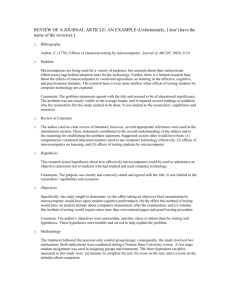
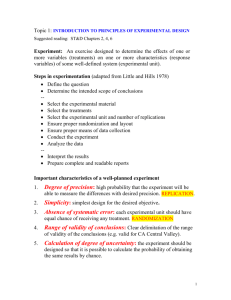
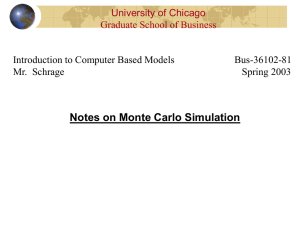
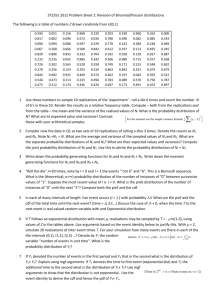
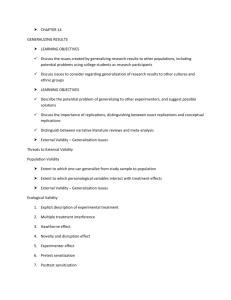
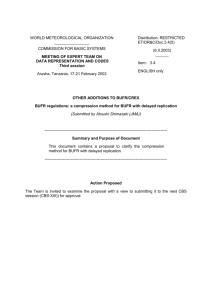
![Topic 1: The Scientific Method and Statistical Models [S&T Ch 1-3]](http://s3.studylib.net/store/data/005853118_1-25a42d92eaa00052e81d5252cf7e7a99-300x300.png)
